Theo Verelst Local Diary Page 37
I've ditched the usual header for the
moment, I think it doesn't help much anyhow.
This page is copyrighted by me, and may be read and transfered by any
means only as a whole and including the references to me. I
guess thats normal.
Mon Dec 25 2:03, 2006
Strange christmas night in a strange town, with a strange setup (a
notebook and a 21 inch screen connected with it and powerfull
applications running on more than 1 computer), but kind of fun, with
some TV (after the owner of the new ´media box´ from the
cable company was not using the remote) in a strange way: decoded from
the digital cable channels (almost all for free for a few months to try
them out) the analog output goes to a pinnacle real time hardware
encoder box, which squeezed 5Mb/s over a Usb-2 link to a (fedora core
4/64) fairly fast linux server, which runs a script to make that stream
available over a local network (with consumer grade router containing
the adsl modem which serves this page to the world to read) where a
notebook runs a complementary script which feeds ´mplayer´
which runs on the secondary screen in good looking full screen mode.
There are worse things than ´strange´...
I've been thinking about Preparatory Film making work, and came up with
* course
I at a good point in time took a serious couse recording video. Not how
to switch a handycam on, or a cozy talk with ramblings about the
subject, but a decent semi pro course to make a script, a stortbook,
and implement the setting up of the lighting, the camera setup and
shooting, and the editing on a semi-pro edit table and of course
beaming and making the sound. I after the course regularly used one of
the big cameras of the Delft University Cultural centre to make
good recordings. The end of the course was a project to make a short
movie, for which I also composed and played a soundtrack, linked over
smpte with a midi sequencer on a computer. I guess it was a very good
idea to do the (fairly long) course, I never regretted having learned
doing decent white-balances the accepted course of events with a
storybook and good attention for the camera motions to be decent and
functional. If your videos make people seasick, you don't know wether
it is possible to change those blue outside lights when filming and you
are sure you could make a Spielberg equivalent from the top of your
head, then either don't bother comparing, or do a good course!
* lighting
Over the years I've played with various lighting conditions, from the
extensive stage lights (which I fixed) at highschool to more reent
trying out of various halogen lights for low budget video shooting. Of
course a good set of spotlights and some diffusors would be good.
* players
Probably one of the more interesting recordings I did in this respect
was from a stage play in Delft, though of course in general it is hard
to find good actors and to motivate and 'get' them to work good on
film.
* coding
In this time almost everything turns digtial at some point, or is
digital from the start, so the format or standard, and especially also
the compression format is important and a source of many troubles and
unclarities and 'bugs'. Some people seem to like deficiencies to
play with, I like to think working HD on the internet.
* test recordings
I've recently started to record in High Definition format, which means
a whole lot more pixels then you can see on a normal TV or even a
computer screen 1920 x 1080 ! That's great because working with so
accurate video resembles film to an extend, and looks real good when
done right, and is a interesting challenge. Of course, like with 'real'
film, more accuracy requires more and more accurate work. Just
'swinging the cam around' is NEVER good enough for anything but home
video, but in HD even with motion estimation as postprocess hand shot
footage is most like a total waste except fot the fun of it. Unusable
for the most part. So luckily I now use a very cheap but good tripod
and film like qualites are starting to come along.
Some test footage, which I might use for a film later on I shot at
Artis (a Zoo) in Amsterdam, like this shot from a aquarium:

Clearly you need a big screen to view this screendump from windows
media player, which shows the size of the images which come by at 25
per second...
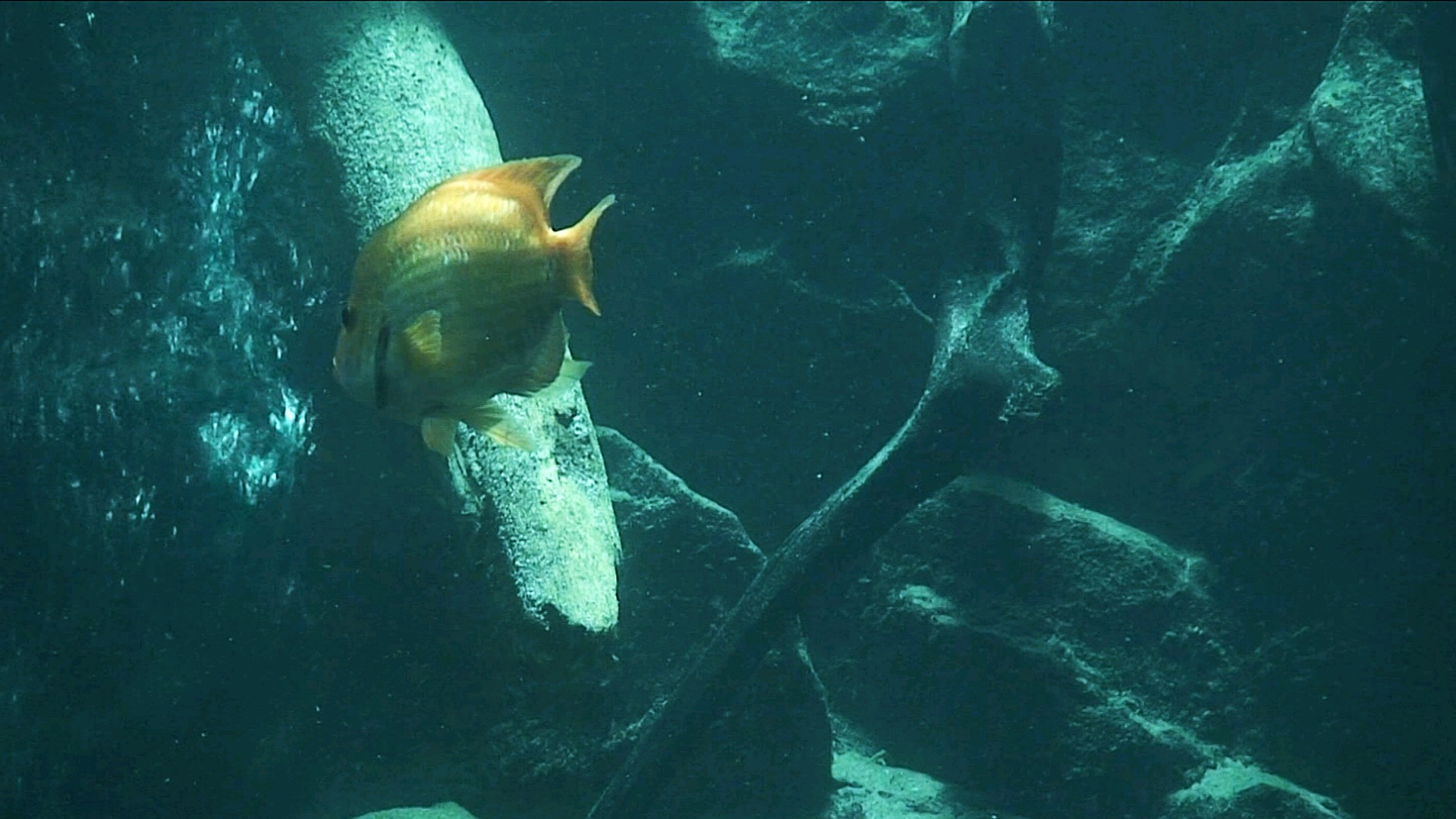
The water was blue and there are all kinds of breaking and wave effects
which show up a lot better if you could see the image move.
The fun is of course that this is like making 25 2 megapixel photos per
second.
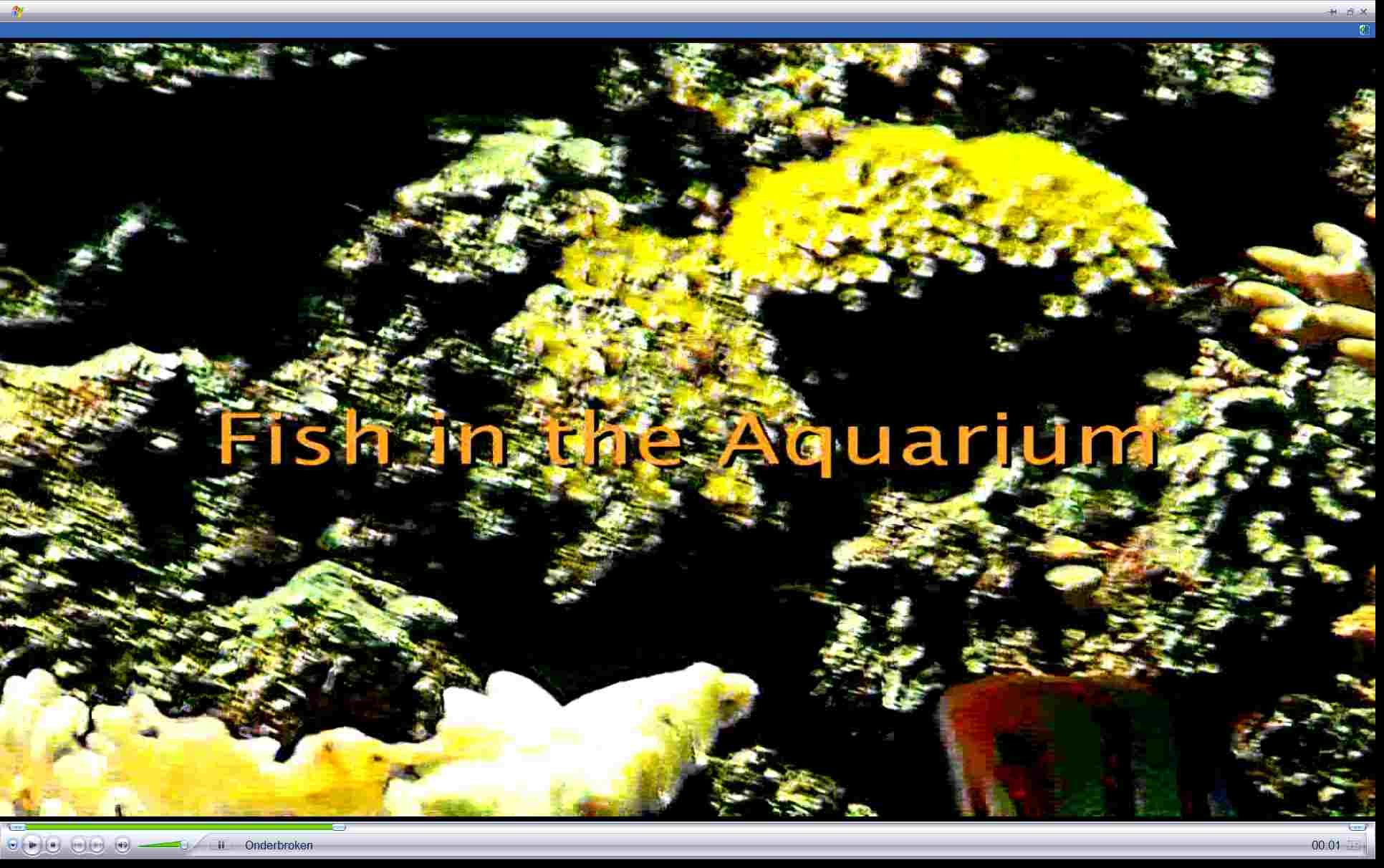
Above a test of an edited piece where the cam moves and the scene is
clearly vague, but there is a title imposed by Cinelerra, a Linux
editing program.

Image quality is a bit poor in this picture, but there is now more
clearity in the background, while the fish is moving.

During playback with sufficient framerate, the above looks fairly good,
if I recall correctly I did adaptive filtering to improve colours,
except I don't have full motion estimation software (or Hardware
...........) and only a real good deinterlacer in the NVidia Purevideo
viewer which is part of windows media player, not of the processing
software I can use, so the moving fish in the still above looks
interlaced.
Another test is this plant setup, here photographed with a (decent) 5
Megapixel digital camera:

The following image is an averaging of a number of HD frames but with
32 bits floating per colour (a whopping 96 or with RGBA 128 bits per
pixel!), and probably some other processing:

Here I've added an amount of an equalized version (in High Dynamic
Range, probably 1 bits per colour) to the above, to give another visual
effect:

Nice to play with.
Is christianity out forever ?
Well, honestly what I found during my life, in sound doctrine and the
supposed word of God (and God the Holy Spirit) reminds me of my
highschool lessons greek and latin and about the general literature
doctrine of the classical hero: be dies doing good. I clearly recall I
felt anguish about trying that thought and half raped in my sense of
righteousness, because I thought that idea was wrong: a saving her, who
does good and no wrong, and who indeed saves should not be dead, but
alive. btw, I only did latin and greek for at most a year, I dropped
those courses because my beta course list (the heaviest possible:
physics, math (I and II), economics, chemistry, english, dutch) was
good enough, and I found it absolutel for dorks to on average score
more than a 9 (out of ten) and then not all the time, please, and
certainly I saw no need to torture myself with (the idea...) and extra
course for my exam. Sjeez, as if I had no hobbies or friends.
Anyhow, christians by and large ended up as almost the opposite of
heros (anti-christs ?), and are even proud of it, and I see that not
change during my lifetime. Of course some were both real and hero and truly
sent by God and Christ and worthwhile and worthy of honour. But today ?
You tell me who that would be.
My dutch exam work at highschool (this was like in the 80´s) was
about humor. I´d only go back in history (like my work on hebrew
translation) when there is a reason, this guy is not:
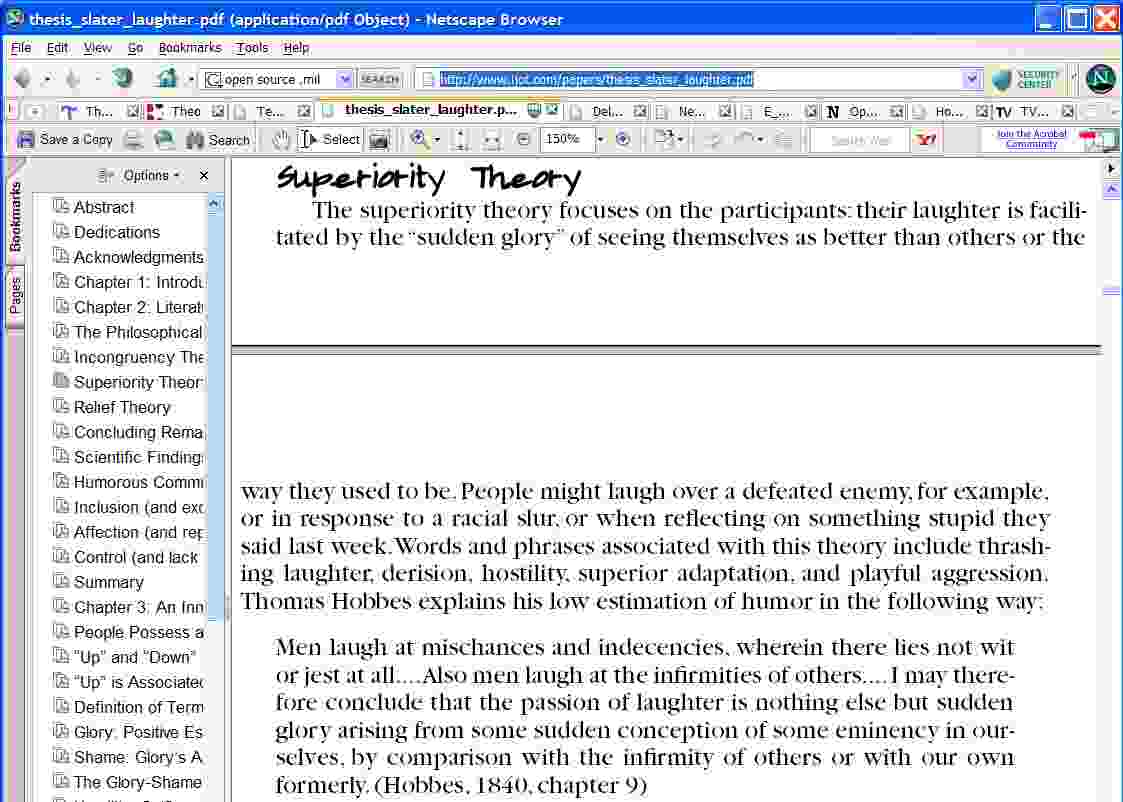
Open Source in the army: hi ha!
Quote:
"Delta3D is looking for a senior
software engineer to work on the leading military open source game
engine"
Yeah yeah the army too is in open source, well, good. A game engine?
"Lets put all our transputers to work on this cool war-by-wire internet
Quake"?! Well, you can always say ´no´! Like people in the
army did recently when Kerry came to town, which I read on netscape.
One, two...
Or maybe we could start an olympic math game hierarchy and that the
best open source program may win: http://web.usna.navy.mil/~wdj/opensource_math.html.
I guess mandelbrot would win the marketing prize for now.
Star Trek on the higher definition BBC Sat
I had to record that on disc in space travelled-bbc encoded 576
widescreen and progressive format of course, presuming all the bits
travelled without change over the digisat protocol which may have used
retransmitted packages to get it so, but normally it looks ok or ot
disturbes or is gone, nothing much in between, except that the audio
bits are more secure, well, more certain to arrive without the decoder
havng problems with it. It's about 4 megabits per second, whcih is
lower than most TV signal encoders I use produce, with 256 kbps mpeg2
sound at 48kHz which is just enough to work with though I'd prefer 384,
that works most of the time. But the video is pretty good for most
material quite superior to normal TV or cable service boxes in
fact, and with probably progressive techniques goes in the the
direction of HD TV, which I cannot receive at the moment, though the
beep has a test actual HD channel, which in fact I can receivem but not
record or decode because of liitations of the computer receiving the
signal, even though it is a fast and advanced dual channel receiver,
which can receive two digisat signals simultaneously, and even show two
at once. Tante pis like the french say.
So I loaded the whole (!) '79 star trek the movie in cinerella from
that format recording (about 4 gig I suppose), which takes some minutes
to create the little pictues for on th timeline but then its good fun
and very educational to watch the frames as they come by and bing able
to perfectly freeze frame and analize picture for picture and the
motions and ditherings and mini-motions between frames. Th best thing
is to crank up NVidia's purevideo (which works only with windows media
player, I'd love
to have that on Linux, or open source software usable, to circumvent
Vista altogether, possibly going xen or so, and it would even be better
to have acces to the hardware HD-encoder which appears to be lurking in
the better cards...
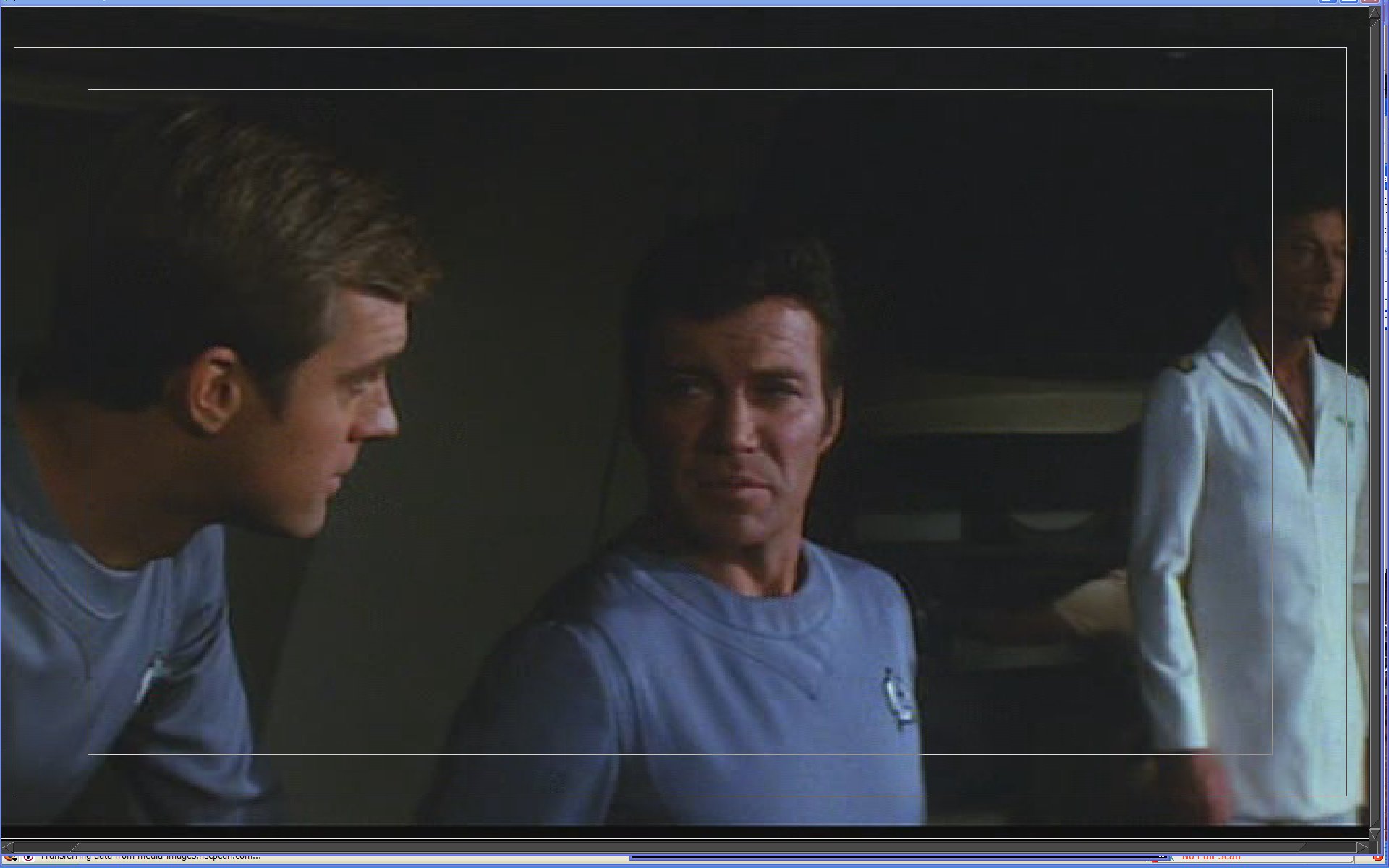
Anyhow, BBC material played full screen on a (near or more than HD)
screen with purevideo is great for TV viewing. Very clearly both in the
film, and in the encoding, tricks and film methods are noticable,
like progressive frmes, averaging noise and sampling artifacts, and
unless I'm very mistaking intelligent dithering to create sufficiently
many derived formats.
A screendump from a Fedora Core 6 / 64 bits Linux workstation (AMD
Athlon 64, 3.3GHz) probably you are viewing this page from the machine
with this screen:
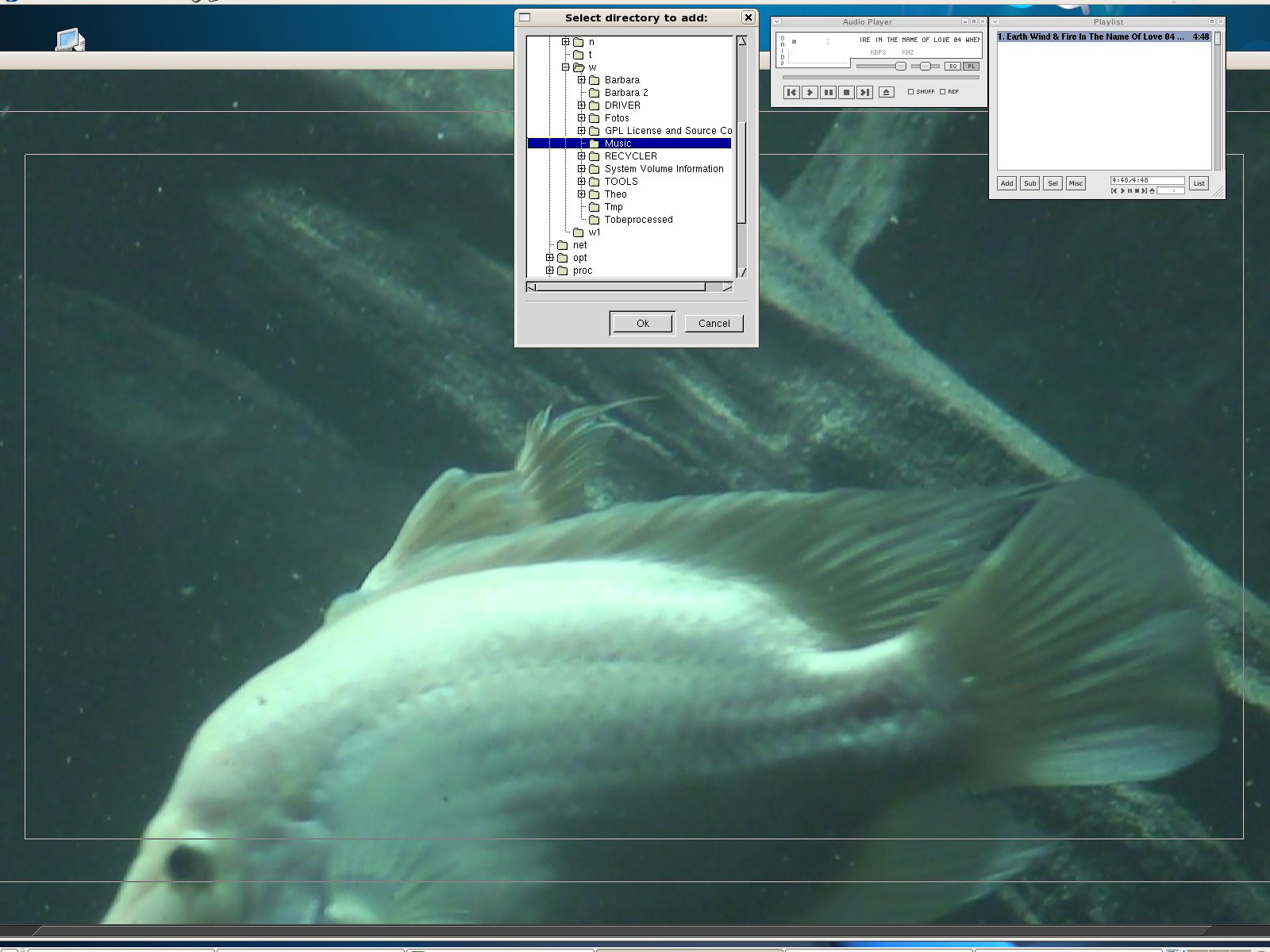
Meanwhile, at the 3D front, I worked more than a bit with Nvidia
Gelato, which is a 3D graphics language, which I also used to render HD
size frames (1920 times 1080 pixels, bigger than most computer screens)
from 3D models. For instance the image below I made from a 3D model (a
long textfile with numbers describing geometries) I found on the
internet. I rendered it with different lighting with Gelato, made the
background transparent, and added a picture in the background from a
real (I think a Nasa telescope) star picture :
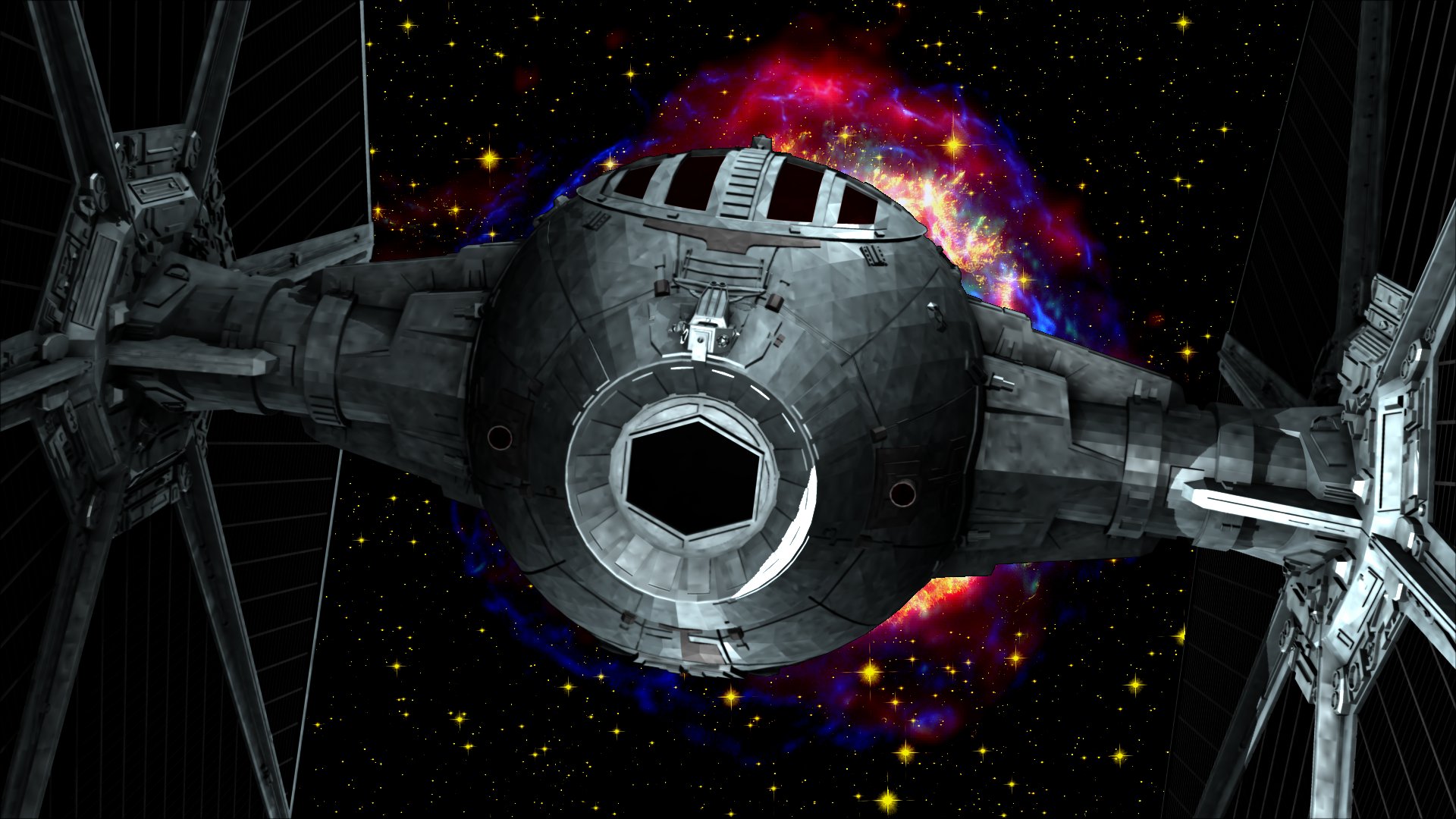
Haha, starwars! These really are graphics, not pictures (except for the
background) Here I added artificial noise (fog) tothe same model
rendered from another angle:
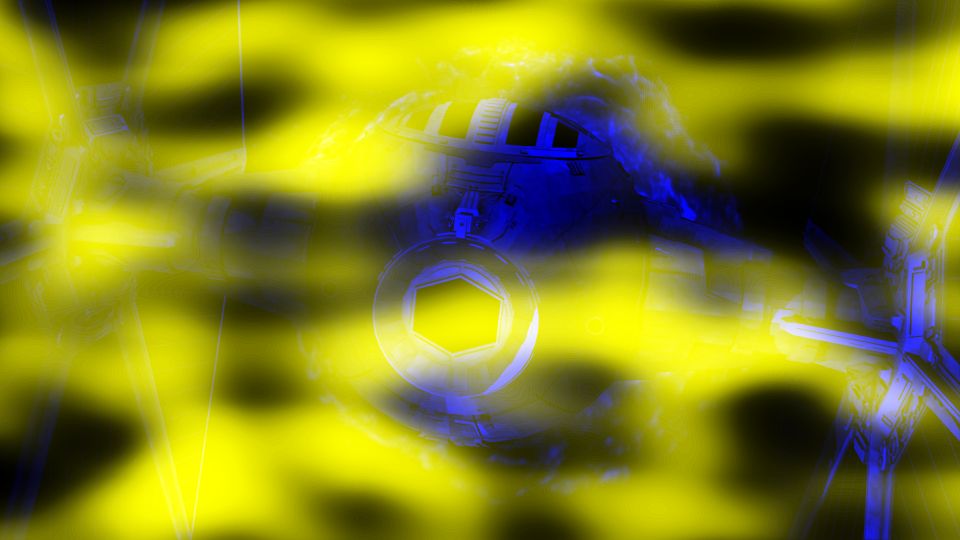
Here is a rendering, again with gelato, with another existing star
background:
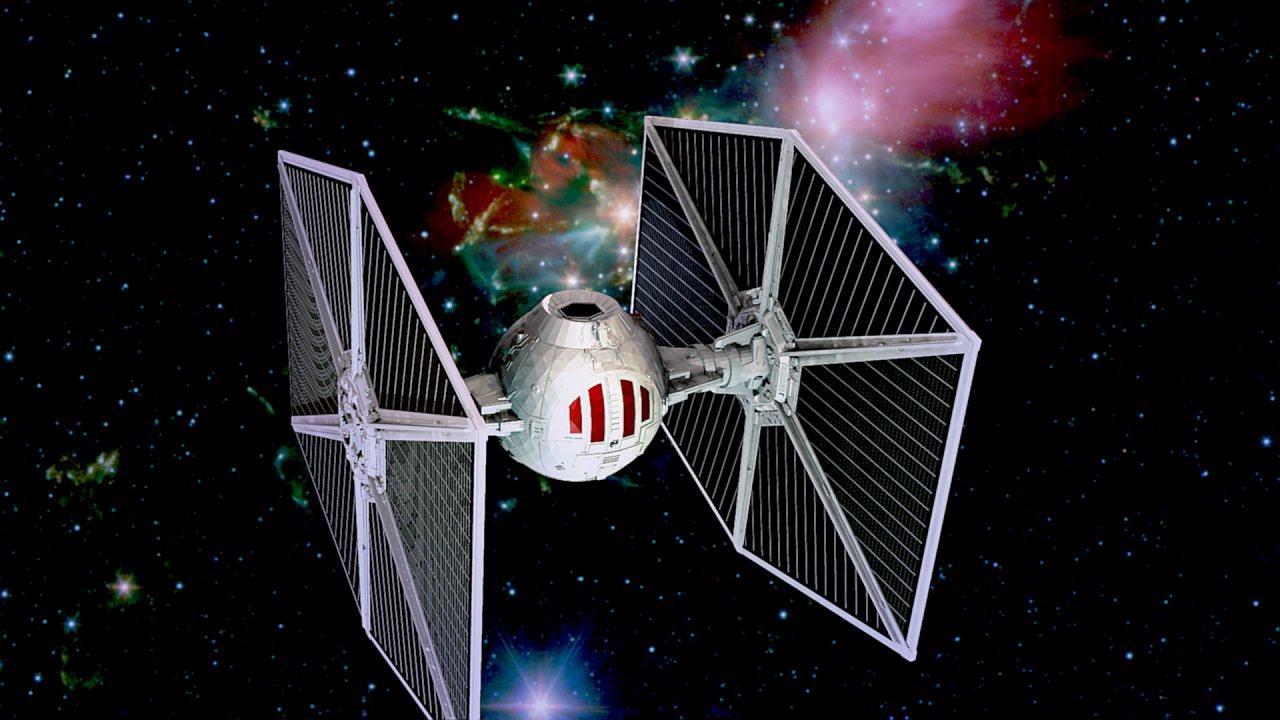 (click
for full HD size)
(click
for full HD size)
The rendering time for these is not sceonds but maybe 12-20 minutes,
but it is possible to put frames like on a row and make movie with it,
and also the frames can be made in HDR and processed as such quite a
bit, also with Cinelerra (the movie edit program with a lot of effects
which also work per frame on HDR data),. which is then high quality HD
movie. Great.
Honestly, when working in at least 16 bits per pixel the format is good
enough for serous cinema movies, which is a major challenge, and of
course hard to make good material for. I render the results in mpeg 2
or mpeg 4 which is more limited but still a 2K frame resolution is
higher than cerain 'official' movies, which leave a lot to the inter or
extrapolation of the projector.
For clarity: I really made the renderings above from an existing 3D
model, I mean I didn't use autocad or so to make the three dimensional
model, but I took such a model and made the rendering myself, which is
cool to do and rewarding when the results are so good as possible with
the hardware accelerated, professional gelato.
Other great shows:

The Commodores drummer, a picture I found on the internet.
The ethernet mixer
Many people in (music) computerland are pretty confused in certain
important aspects, like what is and is not important to achieve good
audio quality.
This list I'd jotted down here for myself to determine the number of
samples of high quality volume controls I have received from Texas
Instruments:
pga4311u 3x + 2 on adapter board
pga2311pa 3x, 1x on arm7020 board, 1x ?
pga2310pa 2x
pga4311ua, 5x
which is enough for a bit of serious multi channel mixing. I want to
use them intelligently with a lot of additional hardware, a FPGA to
drive the volume chips, a linux mini-board to memoriz settings, and
communicate with ethernet and the fpga and a display. This is a test
setup with those parts:
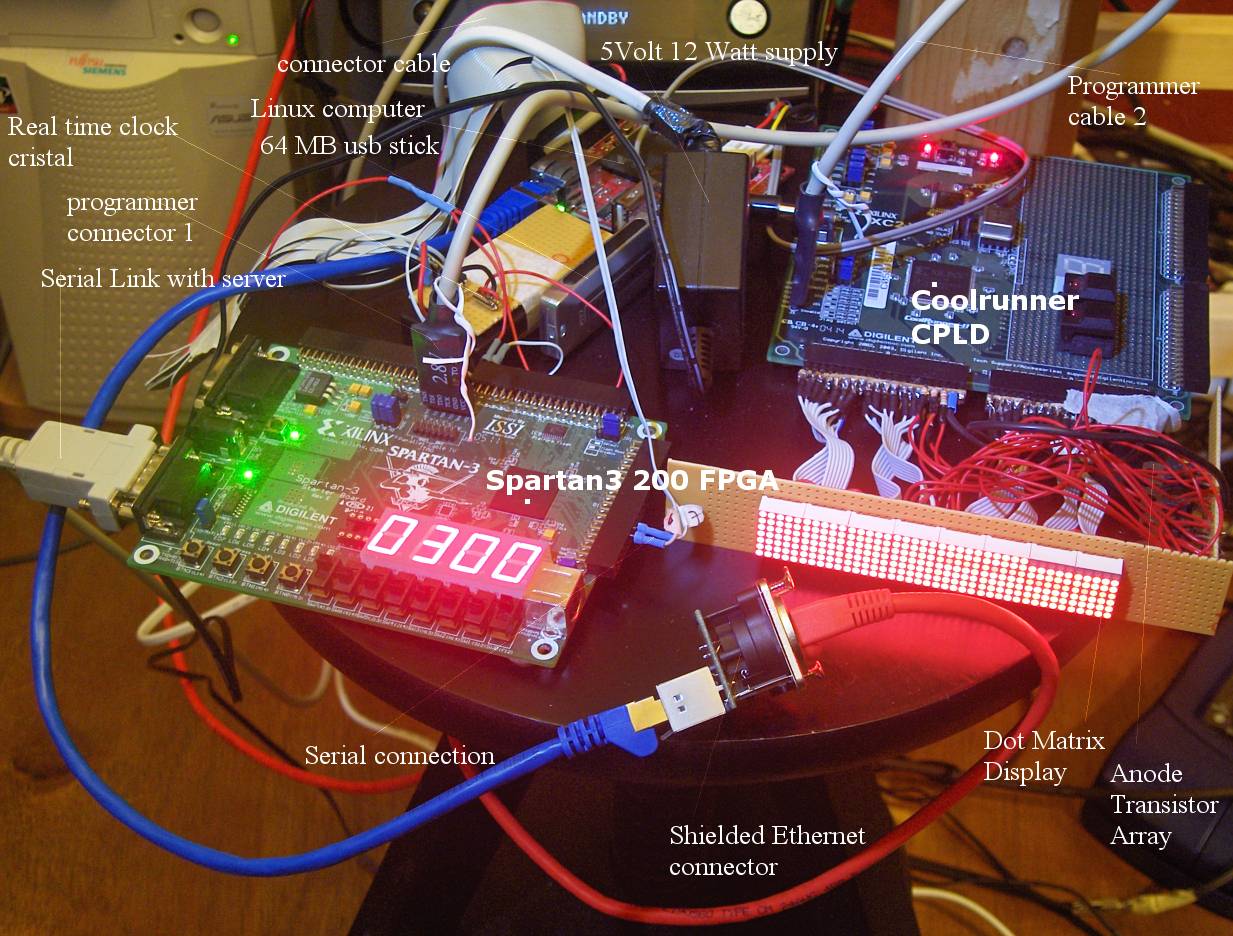
A small working
Linux system connected up with displays, RTC and programmable logic
My setup, as can be read on various pages, is aimed at preferably
compromiseless straight, High Fidelity meaning as little distortion as
possible and low noise, well behaved with transients and of course good
frequency range and transfer straightness and low intermodulation
products, good channel seperation, speaker spread, sufficient power
reserve, and no boom effects instead of solid tight and powerfull deep
bass.
That costs effort, space, weight, ´presence´ of equipment
(big speakers and amps), many parts, expensive electronic filtering,
supplies, quality parts and buildup, speakers and wires, good setup
(ear-height) and acoustics control (damping, placement), and of course
very good sound sources after technical and objective specifications,
not hype and buz or exterior design. Tropical rainwood and ivory are
not going to make your speakers or amp sound better, neither are golden
feet for a cd player or an extra mixer of certain design in your signal
path.
Apart from clear, objective and also hard-to-measure sound quality
there is of course the luxury of a sound system, especially for home
use. Though it has long already been trend to make lets say spartan
high end audio equipment for both objective technical reasons on one
hand, and on the other to make machines look slick. Luxury is probably
more considered for consumer use stereo equipment, like remote control,
lots of controls to play with, and all kinds of handy shapes and
attractive casings.
My main equipment is not searching for compromise as in size, amount of
work and parts, part quality, complexity and weight, though I most
certainly haven´t accessed large sums of money for parts and
tools and research, except for my own intellectual capital. A 3 way
active seperation filter amp setup weighing probably way over 10 kg
composed of 2 19" rack units of 2 high with 6 high quality amp units
and a excellent set of pre-amp and filter chips aren´t $199 in
total, but probably worth less in parts the way I worked than what an
audiofile would spend on one amp alone.
Two four way (4 speaker units) main speakers of 40x40x70 cm
aren´t exactly small or average in number of speakers, and than
an extra sub-woofer cabinet of 50x80x30 housing a 15 inch subwoofer
speaker unit isn´t small or average either.
Driving that system with a very good DA converter from a wav source
sounds excellent, in the sense of high fidelity, but also in terms of
sound power, because amps and speakers allow the whole audio spectrum
to be reproduced at significant sound pressure levels without
distorting easily.
Many recording are made with lesser systems in mind, where various
types of distortion and limitations are compensated to some degree in
the processsed recordings which end up on CD or other sound carrier.
Those recordings sounds still good on this system, but making 24 bit
very good quality recordings without any processing and playing them
back very well honours the classical HiFi thought: playback sound the
same as recording, and this works for a microphone connected to the
system as well: the sound is uncolored and natural and has wide dynamic
range.
Those are no easy objectives and require carefull engineering of the
whole audio path and using high quality (fidelity) ready-made parts,
like the old rule of thumb about audio systems: the whole chain is as
weak as its weakest link (actually less than that), so all parts must
be good. Usually the weakest link is are the speakers, but all parts
have their own weak points.
Mixing consoles are no exception, their nature isn´t very
demanding for electronicists, but as soon as a mixer is added to a good
HiFi system, differences can be heard in sound, just like when using
different pre-amplifiers. In general any addition to the chain where
the sound signal passes through can be heard to degradate sound quality
in more or lesser degree and mixers must be quite expensive, or quite
simple, to keep distortion to a minimum. Lets say the SSL mixer
in main studios probably can be traded for a nice house and a boat to
go with it. Really simple mixers, like I made one with passive parts
only, can have good quality, but more than a few channels, tone and
effect controls and cheap parts can have quite a negative effect on the
sound when compared with expensive HiFi sets.
It is even worse with remote control units controlling the
volume: out of the question for a high end system, absolutely
disastreous.
So I want a quality mixer, remote controllable, computer controllable
even (still worse), without
going digital (no AD DA conversion) which is as transparent as possible
and preferably not limited to a small number of channels and even
surround-capable, and as independent programmable machine.
Thats quite a prototype! Yep, and I´ve not made it all yet, so it
is exciting to aim so high and again have a real ego challence: will it
actually wotk in some reasonable amount of time, and be up to the
challenge of meeting my high audio quality listening standards ?
Well, luckily, I´ve got a working mini-linux system (self
compiled kernel 2.4) with working ethernet interface and webbrowser and
serial connectionsm, and some time ago (around local diary page 20)
I´ve done long experiments with some Texas Instruments digitally
controllable, analog signal path programmable gain amplifier
chips, which gave me satisfactory results, as corresponds with the
factory supplied electronical data about all main audio properties.
And I have a metal 1 unit high 19 inch rack unit ready to be used lying
around with parts like plugs and the system like the picture above. I
can make that work, really, THAT doesn´t make me sweat, it will
be good to have a computer (with MIDI too) controllable mixer with
surround (4 channel) capability and very high quality. I hope...













 (click
for full HD size)
(click
for full HD size)